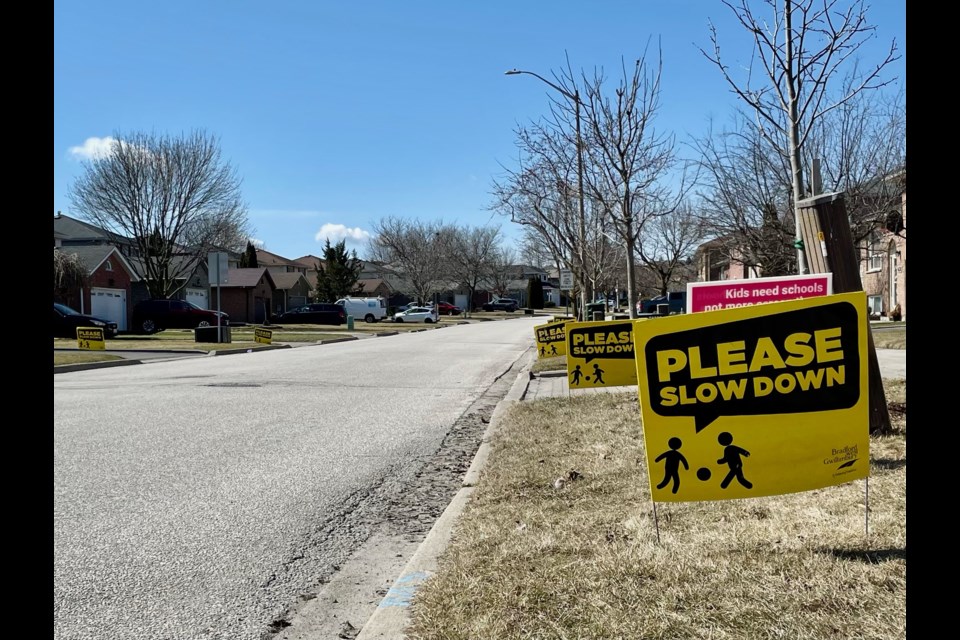There was a slight detour taken by Bradford West Gwillimbury councillors at their March 15 meeting.
When the approval of minutes from the town’s Community and Traffic Safety Committee came to the table, councillors took the chance to have a more holistic discussion on speed control in the community, particularly in the wards represented by Coun. Peter Dykie and Coun. Jonathan Scott.
Dykie had even given a deputation to the traffic committee at its Feb. 24 meeting, speaking primarily to traffic mitigation in place on Collings Avenue, particularly near the entrance to Fuller Park. That deputation led to a request for a staff report focusing on measures on that part of the street, which town council approved.
He took his deputation from the traffic committee further down the road when addressing his colleagues. He brought the concerns from residents on Maplegrove Avenue, particularly between Bronze Crescent and Melbourne Drive back to council’s attention, stating there’s a need for traffic control on the street, whether traffic data backs it up or not.
“People do speed from Melbourne to Bronze,” Dykie said. “Numbers are numbers, but when I see residents place these signs, they see it better than we do. They’re there; they see these cars.”
Dykie was amazed by the sea of yellow “Please Slow Down” lawn signs distributed by the town and placed on lawns along Maplegrove Ave. last summer. Now that the snow has melted, many have been returned.
Those residents want motorists not to drive so fast on Maplegrove, and the experience of Miller Park Avenue has taught Dykie the best speed mitigation is on the road, not on the lawn.
“After looking at the speed bumps on Miller Park Avenue, I’m totally convinced that speed bumps do work,” Dykie said. “They really make the people slow down.”
Letting data dictate where speed bumps go is a more efficient way of traffic control, Deputy Mayor James Leduc suggested, adding “otherwise, we might as well just put bumps all over the place.”
Coun. Gary Lamb, who chairs the Community and Traffic Safety Committee agreed, and suggested many who want speed bumps on their streets should be careful what they wish for, as it might not be the best solution in every instance.
“We went to data because every ward has an issue or a perceived issue,” he said. “I’ve had many people say to me ‘what are you putting those bumps in for? Ninety per cent of the people don’t need them. But it’s for the 10 per cent that do.”
Nor is putting more police officers on certain streets an option, as they could be better served in other parts of town, Lamb said, where a larger proportion of drivers are speeding in excess of 16 km/h over the speed limit.
A limitation to the data is that it allows for council to move reactively to traffic concerns. Coun. Mark Contois suggested there are opportunities to look proactively at issues council and staff are certain to arise prior to becoming problematic.
Side street traffic during the future reconstruction of Holland Street East and Holland Street West was at top of mind.
“We’ve discussed with developers for putting in speed bumps at their cost and they agreed,” he said. “I guess we should look at scenarios, where yes, the application is correct (but) the data isn’t there. We know that when the reconstruction happens and the condo is built, all that traffic is going to go to secondary streets – and we know which streets that they are.”
One place where speed bumps appeared to be warranted – both based on current data and predicted trends – is the south end of Walker Avenue.
Council gave the green light to a second speed bump on Walker Avenue following a recommendation from the traffic committee. As many as 500 to 700 more vehicles are expected to use Walker Avenue daily once the new subdivision south of Line 6 is completed.
This was welcome news to Scott, as it satisfied the area residents and was more representative of the original staff report.
“The data is clear that Walker, despite being a small street, is a street with a real speeding problem and would only get worse if with didn’t take this intervention with the new subdivision to the south,” Scott said.
Lamb added that while data showed the speed bump near Simcoe Road had slowed traffic down on the north end of the street, speeding at the south end had increased, almost as if motorists were trying to make up for the time lost.



